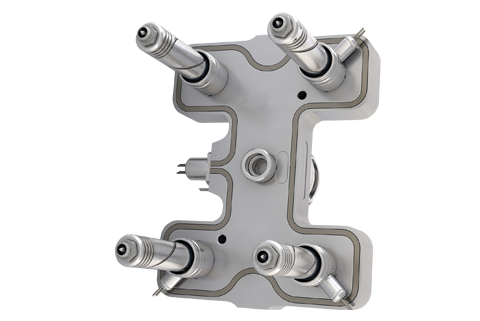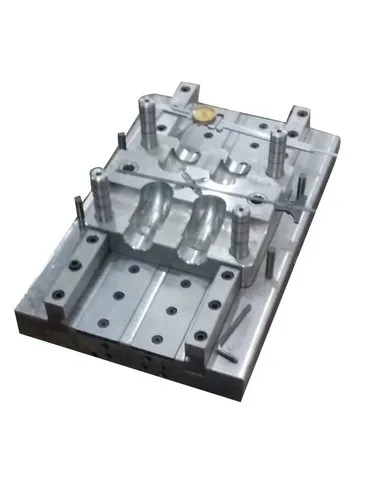In the automotive industry, molding processes play a crucial role in the production of components, from exterior parts to intricate interior elements. The use of hot runners and cold runners in injection molding is an essential decision for manufacturers, as it influences product quality, cycle times, cost-effectiveness, and environmental impact. Here’s an overview of the differences, benefits, and applications of hot runner and cold runner systems in automotive molding:
1. Cold Runner Systems
A cold runner system refers to the portion of the mold that carries the molten plastic from the injection nozzle to the cavities. This system operates at a temperature below the material’s melting point, with the runner material cooling and solidifying after each injection cycle.
Characteristics of Cold Runner Systems:
Runner Cool Down: The material in the runner cools down and solidifies before the injection cycle is complete, leading to material wastage as the solidified runner has to be trimmed and discarded.
Simple Design: Cold runner systems are relatively straightforward, making them cheaper to design and maintain.
Material Waste: As the runner solidifies, it needs to be separated from the molded parts after each cycle, leading to some material wastage.
Limited Control: Since the material cools down in the runner before being injected into the cavity, the ability to control the temperature and flow of the material is limited.
Advantages of Cold Runner Systems:
Lower Initial Cost: Cold runner systems are less expensive to implement because they don’t require temperature control systems or heated components.
Simplicity and Versatility: These systems are easier to set up and can be used for various materials and designs, making them ideal for low-volume or prototype production.
Fewer Maintenance Requirements: With fewer components that need precise temperature regulation, cold runner systems generally require less maintenance.
Challenges of Cold Runner Systems:
Material Waste: The biggest disadvantage of a cold runner system is the waste generated by the runner material. This could lead to higher material costs over time, especially with expensive plastics.
Slower Cycle Times: Cooling times for the runner material add to the overall cycle time, reducing production efficiency.
Post-Processing: Since the runner material must be cut and recycled, the process adds a step in the post-production phase.
2. Hot Runner Systems
A hot runner system keeps the molten plastic in a heated channel, ensuring the material remains in a fluid state until it is injected into the cavity. This system prevents the solidification of material in the runner, eliminating waste and improving cycle times.
Characteristics of Hot Runner Systems:
Temperature Control: The system uses temperature controllers to keep the plastic material at an ideal flow temperature, preventing premature cooling in the runners.
No Material Waste: Since the runner system is heated and material does not solidify, there is little to no waste produced from the runner material.
Complex Design: Hot runner systems are more complex and require precise control over temperature and flow to ensure uniformity and prevent defects.
Advantages of Hot Runner Systems:
Material Efficiency: Hot runners eliminate the need to trim off solidified runners, significantly reducing material waste and costs, especially for expensive plastics.
Faster Cycle Times: Since there is no need for the material to cool and solidify in the runner, cycle times are reduced, leading to higher productivity.
Better Control: Hot runner systems provide more control over the flow of material into the cavity, which is crucial for creating uniform parts with fewer defects.
Higher Precision: The system’s temperature consistency helps maintain the quality and precision of the molded parts, especially in complex or thin-walled designs.
Challenges of Hot Runner Systems:
Higher Initial Investment: Hot runner systems are more expensive due to their complexity and the need for sophisticated temperature control systems.
Maintenance Complexity: Maintaining and troubleshooting hot runner systems requires expertise and can be more costly due to the need for temperature management and sensor maintenance.
Potential for Overheating: If not properly regulated, there is a risk of overheating, which could lead to degradation of material or quality issues.
3. Use in Automotive Molding
In automotive manufacturing, the choice between hot and cold runner systems depends on the specific needs of the application, such as part complexity, volume, material properties, and cost considerations.
Cold Runners in Automotive Molding:
Cold runners are more commonly used in low-volume production or prototype runs. They are suitable for:
Simple Parts: Non-complex automotive components that do not require intricate designs or high precision.
Low-Cost Production: When tooling costs need to be minimized, cold runners offer an economical solution, particularly for small runs.
Non-critical Components: Parts that do not require the highest level of dimensional accuracy or surface finish, such as simple brackets or mounts.
Hot Runners in Automotive Molding:
Hot runners are typically used in high-volume production, where precision and material efficiency are critical. They are commonly applied to:
Complex Parts: Automotive parts with intricate geometries, such as dashboards, door panels, or structural components.
High-Volume Production: Hot runners are ideal when producing large quantities of parts, as they reduce cycle times and minimize waste.
High-Performance Materials: Automotive parts often require specialized materials like reinforced plastics, which can benefit from the more controlled environment of a hot runner system.
Aesthetic and Functional Components: Parts that need to meet strict quality standards, such as visible exterior panels, grilles, or detailed trim pieces.
4. Conclusion:
The decision to use hot or cold runner systems in automotive molding depends on various factors including part complexity, production volume, material type, and cost constraints. Cold runner systems are more economical for low-volume production and simpler parts but come with drawbacks such as material waste and longer cycle times. In contrast, hot runner systems are more suited for high-volume, complex parts where precision, efficiency, and waste reduction are key priorities.
For automotive manufacturers, understanding these differences helps ensure the most efficient and cost-effective molding process for each part, optimizing both production quality and profitability.


